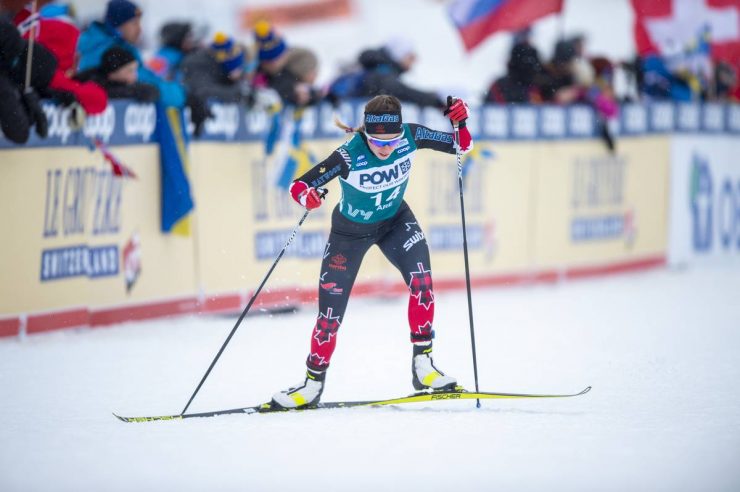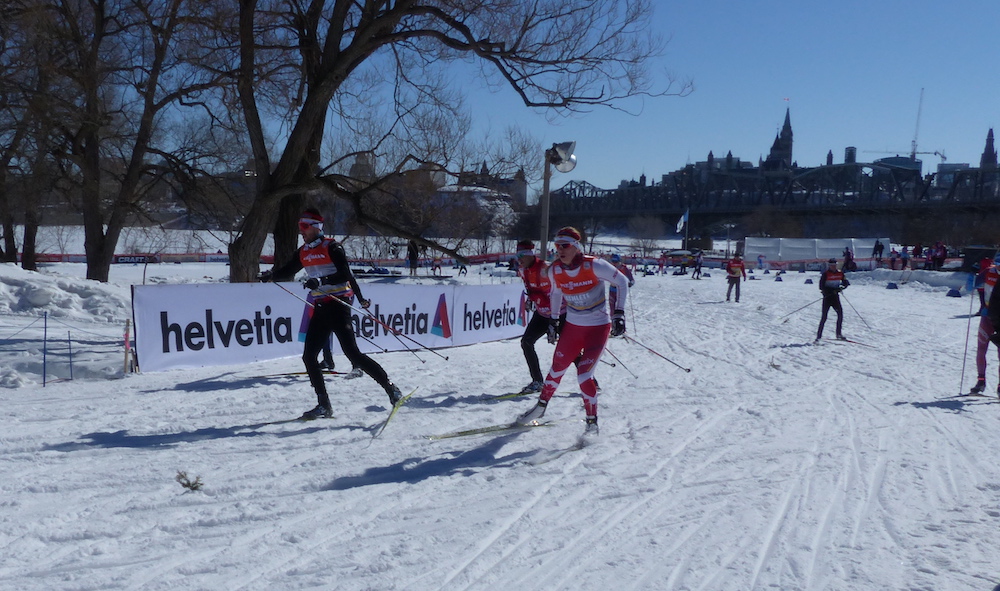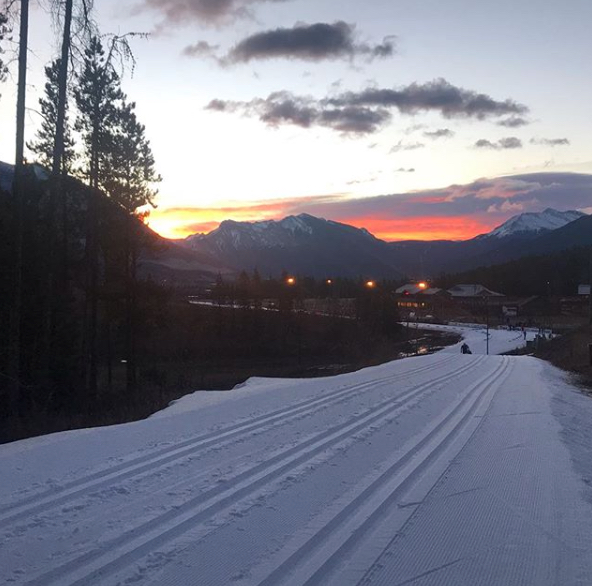
Nordiq Canada’s first major change announcement on November 16th was the decision to cancel the Period I trip to Lillehammer, Dresden, and Davos. (The Lillehammer races have been postponed, and have not been officially rescheduled.)
“For us, it was chatting with our medical experts, assessing the situations here at home and what we were seeing happening overseas,” said Nordiq Canada’s High Performance Director Kate Boyd. “We had never planned to go to Ruka. And then when Lillehammer was postponed to a later time that left two race weekends, and we felt it better that we would stay home, train, get strong. And get a sense of how the protocols were rolling out overseas.”
Those World Cup Covid-19 prevention protocols got their first test in Ruka with varying reports as to the success level. While all the countries were originally satisfied with the plans, it seems that on-site rule interpretation was different than some countries expected. Pierre Mignerey (FIS race director, who is from France) and Norway’s cross-country manager, Espen Bjervig, expressed their differing viewpoints to Norwegian broadcaster NRK shortly after Norway decided to stay home for December.
Mignerey also explained to NRK that one reason some countries might feel more free to criticize FIS safety initiatives relates to business opportunities away from the World Cup for some.
“It is important to understand that for many nations, competing in the World Cup is the only way to do their job and promote their sponsors,” said Mignerey according to a translation. “Norway does not come to the World Cup, but can arrange national competitions that go on TV. They have no chance of that in countries other than Norway, Sweden and Finland.”
After Ruka, Norway, Sweden, and Finland withdrew from the December World Cups. The Norwegians held a national level competition this past weekend in Lillehammer, site of the aforementioned postponed World Cups. Consider that opportune exposure for Norwegian athletes and sponsors – the opportunity cost of missing a World Cup for some is cushioned when the domestic event is broadcast nationally.
Here in Canada, Jeff Ellis, the Partnership and Events Coordinator at Nordiq Canada, commented that the withdrawal of teams like Norway, comes close to a time when that team’s leadership had advocated for maintaining the Lillehammer World Cups as scheduled for December 4-6.
“What Norway has decided to do will be an interesting study on how it affects other teams’ decisions,” said Ellis. “It’s interesting that less than three weeks ago Norway was fighting hard to keep the Lillehammer World Cups with the Head Coach saying we must race as much as possible.”
Canadian reactions to the Period I modifications range from anger to relief. Norway’s, Sweden’s, and Finland’s race departures come on the heels of Nordiq Canada gutting their own race calendar on November 30. Below are the major announcements from the November 30 announcement.
- All FIS-sanctioned domestic cross-country ski events scheduled across Canada for the 2020-21 season are cancelled (Divisions will continue to determine the relevance and possibility of hosting scaled-down local events that meet regional health and safety guidelines);
- Canadian World Championship Trials scheduled for Whistler, B.C. (January 7-10) are cancelled;
- 2021 Canadian Ski Championships (March 14-20) planned at the Nakkertok Nordic Ski Centre in the Ottawa-Gatineau region are cancelled;
- 2021 World Para Snow Sport Championships scheduled for February 7-20 in Lillehammer, Norway have been postponed to January 2022;
When asked about feedback on the recent Canadian World Cup trip cancellation and the subsequent cancellation of FIS races in Canada, Boyd tactfully replied “We have a very passionate community.”
She sees the strong opinions as an opportunity.
“When you’ve got a community as passionate as ours, it can be an incredible force to move us forward, when we’re all moving in the same direction. So I’m hoping that with a good plan and strong communication with that group that we can turn that bus around.
“We’re going to try our best to get to Europe to compete, but we’ll be assessing regularly what we can and can’t do. Always with the athlete safety first and foremost.”
The loss of World Cup opportunities matters. Start spots for Canadian skiers at the Beijing Olympics depend on results from two seasons, including this current season.
“We recognize that we stand a better chance of securing more spots for Canada if we do get to Europe, and have good races and score well in the nation’s points,” added Boyd. “So that is certainly a deciding factor for us to get over to Europe when we can, when it’s safe to do so. We want to give our athletes about as many opportunities and the best opportunities to compete, especially at Games.”
Canada is planning to send athletes to some international events in 2021:
- January (P3) – Ulricehamm, SWE; Lahti, FIN; Falun, SWE; Reserve weekend (TBC)
- February – Nove Mesto, CZE
- March – Oslo, NOR; Test event CHN (tentative)
As far as the cancellation of FIS sanctioned racing in Canada, Boyd suggested the move simplified an already complex pandemic-rattled season. “We figured we’d take the FIS heat off and allow the provinces to host events, when and how they can,” said Boyd. “And it also removes the need for athletes to have to travel outside of provinces to try to get the points.”
During the summer, Nordiq Canada decided to split the traditional NorAm (Continental Cup) series into East and West series, respectively, to reduce travel while increasing the probability that events could be held. This change was also part of a multi-year project to reduce the cost of race travel for Canadian skiers.
The season plans started shifting with the downgrading of the first four East/West NorAm races in December from FIS to regionally sanctioned events. This happened one by one in the first half of November as it became clear that inter-provincial travel for sports events would not restart before the new year. Each province has its own rules which change as the active COVID-19 case load changes.
In early November when Nakkertok was cancelled, it was illegal to drive across the bridge from Ottawa to ski, affecting roughly half of the host clubs’ members. The Canmore event, for example, scheduled for December 12th and 13th, could have proceeded with Alberta, Saskatchewan, and Manitoba skiers in attendance, but without BC and the Yukon athletes. Each of the named provinces has since tightened rules further.

By mid-November, it seemed unlikely that Whistler Olympic Park’s Organizing Committee would be allowed to host U23 and Junior World Trials in January. Cancelling now allows the High Performance Committee to start work on new selection criteria that doesn’t include any head to head races. This Trials event was also the test event for 2023 U23/JW World Championships; cancelling early should make it easier to move the test to 2022.
While this mass cancellation greatly helps with provincial rules compliance and simplifies application of the fluoro ban in Canada, it also comes with consequences. There will be no Continental Cup leaders to receive partially funded World Cup starts in Period I next season. It may have longer term effects on Canada’s status with FIS.
Team selection for international trips and next year’s national team will be different too.
“I know one of the questions that will likely come in is just how we’re going to be selecting the team,” Boyd said. “And we’re working on that right now with our high performance committee. Without Junior trials happening in Whistler, we’ll have to, to look at the information that we have available to us. And pick the fairest and most competitive team that we can send over to Europe to compete.”
For now, it appears regional races may skew in favour of interval starts to manage group size limits. According to Ellis, this format may have an upside.
“This is my personal opinion, but I think we [Canada] have traditionally been weak at Interval Start,” said Ellis. “We seem to need that push from others around us to see what we can do. Whether that be in sprint heats, mass start or pursuit start. Our successes usually begins there. A season of interval starts and learning how to really push oneself could be really valuable.”
National Team coach Erik Bråten told FasterSkier last May he felt many Canadians were relying on the group to pace training sessions.
“There are a lot more organized trainings here then I am used to, with programs having 4-6 sessions a week together in addition to camps,” said Bråten. “I think a lot of athletes will learn a lot about intensity control and focus in training these next few months. And when we are allowed to be in bigger groups again, let’s use that focus and self awareness to have even better group sessions then we did before.”
The NorAm series still carries the name from when it was truly a Continental Cup, with races in Canada and the USA. Once the SuperTour series started in the U.S., the NorAm series was left as a Canadian series with an outdated name.
“In terms of reducing travel there will always be the need to get our best skiers together a certain amount of times a year. Geography is our reality and we can’t avoid having to travel for top level events,” Ellis wrote. “The FIS Regional Cup series was an attempt this season to get away from the NorAm calendar but with the cancellation of FIS events we didn’t get a chance to see how that goes”
Ellis is bound at every turn by FIS rules but he doesn’t want to be limited by the past.
“In terms of what directions we are looking at, we will be looking at whether our NorAm (Continental Cup) series was achieving what it is designed to do. I’d like to see us stick with regional FIS events where teams could choose to race south of the border if financially and competition-wise that makes more sense. We would still need to get together a few times a year for Trials, Nationals etc. But maybe a NorAm series doesn’t need to dominate the calendar. In the end it’s just the Open category that is FIS sanctioned and it has the Continental Cup tag just like OPA or Scandinavian Cups.”
Boyd is open to new ideas in her role with the team.
“This is how Canada has done it in the past, but it’s a new era, right? And new opportunities to see where we can just…. How do we make the Canadian system exceptional, but also make it really clear and transparent. And so people know what it is going to take to be on the national team and to compete for Canada.”
Fluoro Wax Ban in tier 2 racing
Canada is moving forward with their fluoro ban this season
. It is a small change from last year’s LF-only racing below the Continental Cup and World Cup level (tier 1 aka FIS-sanctioned).
“This pause in FIS competitions gives everyone another season to prepare for the fluoro-free future of the sport,” added Ellis. “All signs point to us having a hand held fluoro tracker device for next season. We will be able to check at the start line for fluorinated wax products on skis and athletes will be not allowed to start that race. It should be noted that fluoros are a banned substance this season at all Nordiq Canada sanctioned events and will be at the FIS sanctioned ones next season. Putting them on skis is a banned performance enhancing substance. In general I am not worried about our competitive ski community trying to cheat the system but some will and I look forward to catching them.”
NC is also looking at virtual racing.
“We are looking at a number of options,” said Ellis. “Strava obviously plays well into very specific site competitions. We certainly have many skiers who are very familiar with that data tracking service and I think it plays well into running virtual events this season. Specifically, Loppets where we can’t have large groups starting together. Having the multiple segments over the course of a long distance event could engage more people that wouldn’t necessarily make a traditional podium. Best first lap, fastest final 100m or uphill and downhill challenges. Primes during a mid race segment. Lots of great options. The iSki tracking app is also something we are taking a look at. Could we have a Nordic Challenge that is over a 10 day period or the entire season where we see who can ski the most kms. Although it won’t be a normal year there are a lot of opportunities for us to try new things.”
COVID-19 Outbreaks

The first widely publicized North America outbreak in cross-country skiing occurred in Canmore this November. A group that had travelled to Canmore for on-snow training at Frozen Thunder had a number of people test positive. Canada has fairly strict privacy laws on medical issues, which limits how much anyone can share about individual cases. As a result, Boyd was limited in what she could say and FasterSkier is limited in how much we can share.
“It was contained to one cohort,” said Boyd. “Which, I think, considering everybody that was out skiing at Frozen Thunder, I think it demonstrated that it’s not something that we saw evidence as transmitting [outdoors] in our sport.”
Many teams took the opportunity to train at Frozen Thunder. Canmore Nordic Centre’s policy during FT was only 100 skiers permitted on-trail at any single time.
“I think that the protocol that we have for our outdoor training for our team seems to be working well,” said Boyd about skiing at the centre. “Yeah, it was a group that did travel here to train and so not necessarily under the team’s purview.”



